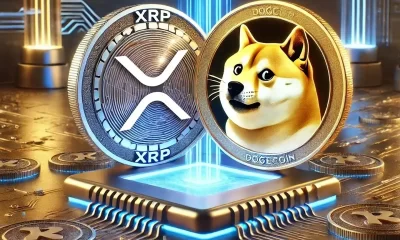crypto education
SynFutures launches Perp Launchpad with $1m grant for new tokens
Published
2 weeks agoon
By
admin

SynFutures, a decentralized derivatives trading platform, has launched its Perp Launchpad, designed to help crypto projects establish perpetual futures markets.
The platform’s objective is to increase trading access for lesser-known tokens, offering more opportunities for users to engage with a diverse range of digital assets, according to a SynFutures press release.
Introducing SynFutures Perp Launchpad + a $1,000,000 Grant 🎉
This is the first ever crypto derivatives launchpad. Now, any project can launch perpetual futures trading pairs for any crypto asset.
Additionally, SynFutures is allocating $1 million Perp Launchpad Grant to support… pic.twitter.com/WUZ6NuyHT2— SynFutures (@SynFuturesDefi) November 5, 2024
This launchpad stands out as it specifically focuses on perpetual futures markets, a type of derivatives market. Perpetual futures are contracts that remain open indefinitely and are often used for leveraged trading.
This launchpad is also unique because most launchpads in the crypto space focus on spot trading, or direct asset trading.
$1 million grant for token projects
As part of the initiative, SynFutures is introducing a $1 million grant program to support token projects by providing financial backing, liquidity, and marketing assistance, helping new projects increase visibility and attract users.
By expanding derivatives access, SynFutures enables these projects to list tokens and offer additional ways for communities to engage through trading and liquidity provision.
Initially, the Perp Launchpad will operate on Base, an Ethereum (ETH)-based layer 2 network, allowing projects to create perpetual trading pairs for their tokens. SynFutures has already partnered with established projects like Lido and Solv Protocol, significantly growing its ecosystem since July 2024.
SynFutures’ launchpad also caters to individual traders, giving access to a broader range of tokens, including popular memecoins. The platform offers incentives to encourage trader engagement in on-chain derivatives markets, such as trading competitions.
Source link
You may like


Bankrupt Crypto Exchange FTX Set To Begin Paying Creditors and Customers in Early 2025, Says CEO


Top crypto traders’ picks for explosive growth by 2025


3 Tokens Ready to 100x After XRP ETF Gets Approval


Gary Gensler’s Departure Is No Triumph For Bitcoin


Magic Eden Token Airdrop Date Set as Pre-Market Value Hits $562 Million


Blockchain Association urges Trump to prioritize crypto during first 100 days
crypto education
What is a crypto swap? Crypto swaps explained simply
Published
2 weeks agoon
November 8, 2024By
admin

A token swap, or crypto swap, is like trading your favorite Pokemon cards with anyone you like online. But instead of trading cards, you can trade digital crypto assets in exchange for your favorite crypto tokens, often, without a conventional centralized crypto exchange.
In this article, we take a deep dive into crypto token swaps, common types of swaps, how they work, and how you can perform a crypto swap easily.
What is a crypto swap?
What is a crypto swap?
A crypto swap is an exchange of cryptocurrencies usually performed on dedicated swap platforms, or decentralized exchanges (DEX).
Instead of going the traditional way of selling a fiat currency for a crypto token, you can directly swap crypto tokens. This is helpful especially if you want to avoid KYC restrictions and don’t want to pay additional fees associated with centralized crypto exchanges.
Swapping tokens in crypto can be done on the same blockchain or across different blockchains, a feature offered by almost every decentralized crypto swap platform. Swapping cryptocurrencies is an ideal way to rebalance your crypto holdings, or step foot into the exciting world of decentralized finance (DeFi) where lending and borrowing can be a game changer for many users.
Types of Token Swaps
Token swaps can have many types, but the most common and important categories include on-chain and off-chain swaps.
Centralized exchanges usually carry out off-chain swaps, facilitating the transaction inside their own database as opposed to on a public ledger. Although this kind of token swap is quicker and might have cheaper costs, it presupposes confidence in a centralized exchange.
On the other hand, on-chain swaps take place solely on the blockchain and manage user-to-user transactions via smart contracts. These on-chain swaps are very common on DEX platforms like Uniswap and PancakeSwap, where buyers and sellers conduct on-chain transactions with each other via decentralized processes.
Both types of cryptocurrency swaps have special benefits: off-chain swaps give efficiency and speed, while on-chain swaps offer transparency and decentralization. You can choose any type of token swap based on your comfort level with speed, security, and control over your assets.
Common use cases
For several reasons, token swaps are becoming more and more common, particularly in the DeFi community. Portfolio diversification is one of the main use cases; investors can simply exchange crypto tokens to distribute their funds among several projects without leaving the cryptocurrency market. Yield farming, in which users exchange tokens needed to engage in yield-generating activities on DeFi platforms, is another popular application.
Since some projects only work with particular crypto tokens, swapping tokens in cryptocurrency is also useful for accessing decentralized applications (dApps) and making NFT purchases. For example, a token swap allows you to join a gaming platform that requires a specific cryptocurrency asset with little difficulty. As a result, token swaps are now an essential component of the crypto toolbox, facilitating user interaction with a variety of applications.
How do crypto swaps work?
There are some key fundamental ways in which cryptocurrency swaps work, and they frequently differ depending on whether they are off-chain or on-chain.
Smart contracts play a key role in on-chain swaps. The smart contract returns the swapped token to the user after locking the original token in escrow when a user initiates a swap. Because these transactions are decentralized and trustless, users maintain complete control over their money throughout the transaction, negating the need for an intermediary.
Cryptocurrency traders provide liquidity to liquidity pools provided by decentralized exchanges (DEXs). This allows other users to swap their favorite tokens and essentially creates an organic marketplace of buyers and sellers, which eliminates the need of traditional order books.
On the other hand, off-chain swaps are purely conducted on centralized exchanges, hence their data is not recorded on any public blockchain. This method allows users to benefit from lower fees and faster transaction processing times.
Both on-chain and off-chain swaps have different benefits when it comes to transparency, speed, and cost, which allows users the liberty to choose the method that suits their needs. With crypto swaps explained, let’s move on to why they’re important.
Why are token swaps important in crypto?
The crypto ecosystem can only thrive if its accessibility and functionality become at par with the understanding of crypto users. This is where token swaps come into the picture, as they fulfill both these parameters.
Token swaps give users the liberty to adapt to volatile crypto market conditions as they can easily get new tokens by participating in DeFi activities including staking, lending, and yield farming. In addition, users can also diversify their portfolios and swap tokens through liquidity pools. All of this opens up a new pathway for new crypto users to get familiar with the world of web3.
The benefits of token swaps aren’t just limited to the crypto user. Blockchains also benefit from token swaps, as their interoperability is enhanced, thanks to cross-chain swaps, that facilitate the exchange of assets between blockchains.
This entire procedure attracts new investment and promotes innovation across blockchain projects that start to provide a more diverse amount of tokens and DeFi platforms to the end users.
Crypto token swap vs token migration
A token swap is defined as exchanging one cryptocurrency for another, which can be on the same blockchain or across different blockchains. The process of token swapping allows users to diversify their crypto asset holdings and reposition themselves in the volatile cryptocurrency markets.
On the other hand, token migration is the process of a cryptocurrency project moving from one blockchain to another. For example, a layer-1 protocol can decide to move to a layer-2 blockchain to get additional benefits of lower transaction costs and increased speeds.
When token migration happens, usually a cryptocurrency project issues a new token with a new ticker, and all users have the option to seamlessly transition their current holdings to the new one. A recent example of this is $MATIC which was migrated to $POL, and the spot holdings of $MATIC tokens held by users were converted into $POL automatically.
Risks and considerations
Token swaps do offer a certain level of comfort to users, however, they are associated with some risks as well. For example, while doing on-chain swaps cryptocurrency traders can experience issues like slippage, where a swap doesn’t get executed at the intended price levels, which can lead to potential losses.
Another risk is that users have to evaluate the security of the platform on which they are conducting these token swaps. This is because if smart contracts running behind a token-swapping platform are compromised, all funds can be lost.
In off-chain token swaps, users can face the risk of counterparty default, which means that the centralized exchange sometimes fails to execute the transaction properly. While the fees and speed of a transaction might be lower on off-chain token swaps, users still have to analyze the security aspect of the centralized exchange.
In token migrations, users can face issues related to wallet compatibility, lack of support during the transition process, and the crypto exchange not supporting the token migration to begin with. All of these risks can lead to potential losses, and to avoid this, users can make sure that the cryptocurrency project’s team is reliable and has announced a partnership with the exchange before doing the token migration.
How to perform a token swap: step-by-step guide?
A token swap is a simple process, here are some steps you can follow to complete a token swap.
Connect your wallet: Connect or create a digital crypto wallet from scratch, for example, Metamask. Make sure you have the crypto token you want to swap in it.
Choose your swap tokens: Go on any decentralized exchange, for example, Uniswap, and select both tokens, i.e. the token you want to swap and the token you want to get in return.
Enter the amount: Enter the amount of tokens you want to swap.
Double-check the amount and fees: Check the fees displayed on Uniswap that will occur for the entire swap process.
Accept the transaction: Accept the transaction in your digital crypto wallet.
Wait for confirmation: Wait for a few seconds to minutes for the transaction to complete and for the tokens to show in your digital crypto wallet. You have now swapped a token in the cryptocurrency market!
Where to swap crypto?
Crypto swaps can be done on centralized exchanges like Binance, OKX, Coinbase, etc. You can also select a decentralized exchange like PancakeSwap or Uniswap. Both of these options have their own advantages, for example, centralized exchanges offer a user-friendly interface with customer support.
Meanwhile, a DEX platform provides control over your assets and privacy, as there is no requirement to do KYC unlike on the centralized platforms.
Are crypto swaps taxable?
In most countries, crypto swaps can be a taxable transaction. Exchanging cryptocurrencies triggers capital gains or losses so it may be taxable. It is advised to consult a tax expert and also check your country’s laws before engaging in any crypto swap transaction.
Also, do research before engaging in any crypto swaps due to the high risks involved in both off-chain and on-chain swaps. To swap token in crypto, it’s important to know the ins and outs of the exchange or service you’re dealing with as well as tax implications,
Source link

Bankrupt Crypto Exchange FTX Set To Begin Paying Creditors and Customers in Early 2025, Says CEO

Top crypto traders’ picks for explosive growth by 2025

3 Tokens Ready to 100x After XRP ETF Gets Approval

Gary Gensler’s Departure Is No Triumph For Bitcoin

Magic Eden Token Airdrop Date Set as Pre-Market Value Hits $562 Million

Blockchain Association urges Trump to prioritize crypto during first 100 days

Pi Network Coin Price Surges As Key Deadline Nears

How Viable Are BitVM Based Pegs?

UK Government to Draft a Regulatory Framework for Crypto, Stablecoins, Staking in Early 2025

Bitcoin Cash eyes 18% rally

Rare Shiba Inu Price Patterns Hint SHIB Could Double Soon

The Bitcoin Pi Cycle Top Indicator: How to Accurately Time Market Cycle Peaks
Bitcoin Breakout At $93,257 Barrier Fuels Bullish Optimism

Bitcoin Approaches $100K; Retail Investors Stay Steady

Solana Hits New ATH On Huge Whale Accumulation, More Gains Ahead?
182267361726451435

Top Crypto News Headlines of The Week

Why Did Trump Change His Mind on Bitcoin?

New U.S. president must bring clarity to crypto regulation, analyst says

Ethereum, Solana touch key levels as Bitcoin spikes

Bitcoin Open-Source Development Takes The Stage In Nashville

Will XRP Price Defend $0.5 Support If SEC Decides to Appeal?

Bitcoin 20% Surge In 3 Weeks Teases Record-Breaking Potential

Ethereum Crash A Buying Opportunity? This Whale Thinks So

Shiba Inu Price Slips 4% as 3500% Burn Rate Surge Fails to Halt Correction

‘Hamster Kombat’ Airdrop Delayed as Pre-Market Trading for Telegram Game Expands

Washington financial watchdog warns of scam involving fake crypto ‘professors’

Citigroup Executive Steps Down To Explore Crypto
Mostbet Güvenilir Mi – Casino Bonus 2024

Bitcoin flashes indicator that often precedes higher prices: CryptoQuant
Trending

 2 months ago
2 months ago182267361726451435

 24/7 Cryptocurrency News3 months ago
24/7 Cryptocurrency News3 months agoTop Crypto News Headlines of The Week

 Donald Trump4 months ago
Donald Trump4 months agoWhy Did Trump Change His Mind on Bitcoin?

 News3 months ago
News3 months agoNew U.S. president must bring clarity to crypto regulation, analyst says

 Bitcoin4 months ago
Bitcoin4 months agoEthereum, Solana touch key levels as Bitcoin spikes

 Opinion4 months ago
Opinion4 months agoBitcoin Open-Source Development Takes The Stage In Nashville

 Price analysis3 months ago
Price analysis3 months agoWill XRP Price Defend $0.5 Support If SEC Decides to Appeal?

 Bitcoin4 months ago
Bitcoin4 months agoBitcoin 20% Surge In 3 Weeks Teases Record-Breaking Potential


